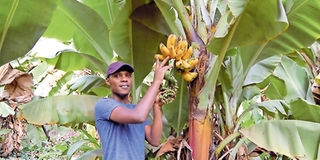Young man who has found wealth in banana side hustle

Patrick Kigen in his quarter-acre banana farm in Ol Rongai, Nakuru County. He mulches the plants using leaves and dry grass to help in conservation of moisture and maintenance of soil fertility besides suppressing unwanted weeds. PHOTO | FRANCIS MUREITHI | NMG
What you need to know:
- To grow the tissue culture bananas of the FHIA 17, Grand naine and Williams varieties, he first digs 1.5 to 2 feet deep holes and maintains a similar width.
- He mulches the plants using leaves and dry grass to help in conservation of moisture and maintenance of soil fertility besides suppressing unwanted weeds.
- Kigen harvests five to 10 bunches of bananas every week, selling each at between Sh200 and Sh800 depending on the size.
- Joseph Gaturuku, the Nakuru County horticulture officer, says for farmers to get maximum returns from bananas, one must continuously do soil analysis.
Clad in a blue T-shirt, a blue cap and matching trouser, Patrick Kigen is on his banana farm in Ol Rongai, Nakuru, uprooting weeds and cutting dry leaves when Seeds of Gold team visits.
The farmer grows the crop on a quarter acre, with the passion to farm bananas having been ignited by his mother Jane Tuigong.
“I used to enjoy eating sweet bananas harvested direct from the farm planted by my mother. This motivated me to start growing them when I grew up,” says Kigen, 28, who has a degree in information and communication technology.
To grow the tissue culture bananas of the FHIA 17, Grand naine and Williams varieties, he first digs 1.5 to 2 feet deep holes and maintains a similar width.
As one digs the holes, it is crucial to separate the top soil from sub soil, he says.
“The plants should be three metres apart. To get healthy plants, one should put well decomposed 2kg manure in each hole and mix properly with the sub soil. One then puts in the seedlings and covers leaving space for watering,” he offers.
He mulches the plants using leaves and dry grass to help in conservation of moisture and maintenance of soil fertility besides suppressing unwanted weeds.
To avoid pests and diseases that affect bananas such as snails, fungal diseases like fusarium wilt and bacterial diseases, he sprays his crop regularly.
“Banana farming is not easy in its formative stages since the crop is affected by viruses that cause diseases such as banana streak and one can lose the entire crop if not careful.” The bananas start fruiting from nine months.
Kigen harvests five to 10 bunches of bananas every week, selling each at between Sh200 and Sh800 depending on the size.
“In a good week, I get between Sh5,000 and Sh10,000 after taking the produce to the local market,” says Kigen, who works as an ICT officer at a firm.
Joseph Gaturuku, the Nakuru County horticulture officer, says for farmers to get maximum returns from bananas, one must continuously do soil analysis.
“This is crucial because bananas take many years on the farm and it is through soil testing that one can establish the presence of diseases such as nematodes and this will ensure healthy growing,” says Gaturuku.
He further advises farmers to water their crops regularly. “Bananas are heavy consumers of water thus need adequate supply and manure to make the crops thrive.”




